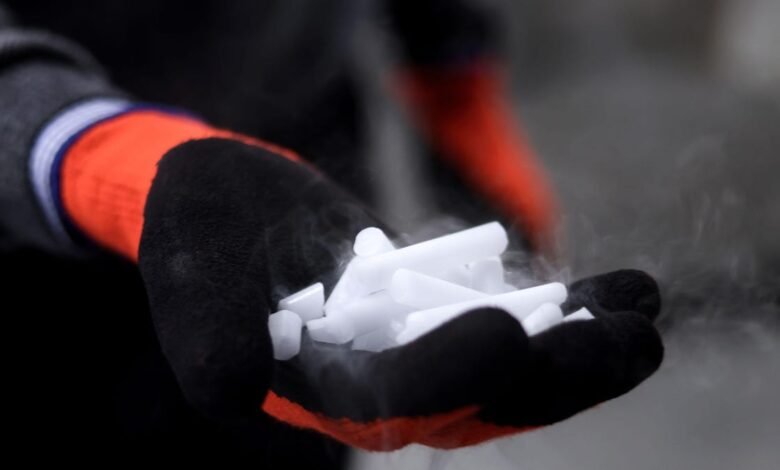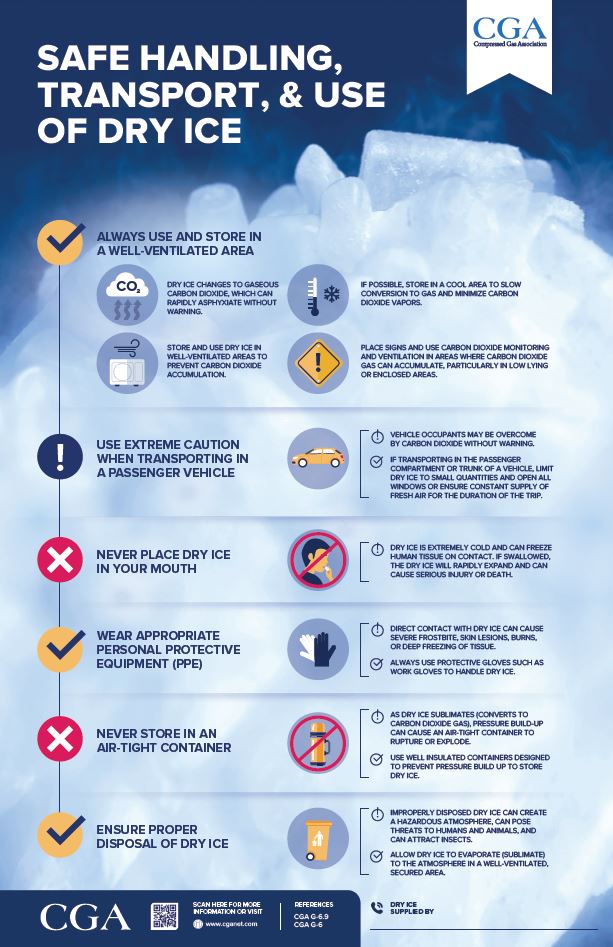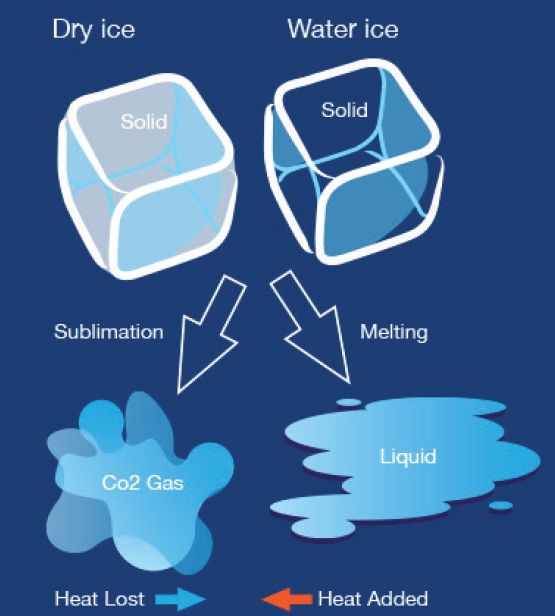How Cold is Dry Ice? Unveiling its Frosty Secrets!

Dry ice is extremely cold, reaching temperatures of -78.5 degrees Celsius (-109.3 degrees Fahrenheit). It is a solid form of carbon dioxide.
Dry ice is known for its freezing capabilities due to its extremely low temperature. With a temperature of -78. 5 degrees Celsius (-109. 3 degrees Fahrenheit), it is much colder than regular ice made from water. This unique characteristic makes dry ice ideal for a variety of applications such as freezing food, creating smoke effects, and preserving perishable items during transportation.
Let’s explore the fascinating properties and uses of dry ice in more detail.

Credit: www.cganet.com
The Mystique Of Dry Ice
What Is Dry Ice?
Dry ice is solid carbon dioxide (CO2) at a temperature of -78.5°C.
A Brief History
Dry ice was first observed in 1835 by French inventor Charles Thilorier.
The Frosty Facts: Temperature Revealed
The Frosty Facts: Temperature Revealed – Dry ice is a fascinating substance with many unique properties. It is commonly used in industries for various purposes such as cooling, preservation, and transportation of goods. However, have you ever wondered why dry ice is so cold? In this article, we will explore the frosty facts about the temperature of dry ice.
Comparing Temperatures
To understand how cold is dry ice, let’s compare its temperature with other commonly known substances. The temperature of dry ice is -78.5°C (-109.3°F), which is much colder than regular ice, which has a temperature of 0°C (32°F). In fact, dry ice is so cold that it can cause frostbite or skin damage if it comes in contact with bare skin.
Why It’s Colder Than Regular Ice
Now, you might be wondering why dry ice is colder than regular ice. The answer lies in the way dry ice is made. Dry ice is produced by compressing and cooling carbon dioxide gas to a temperature of -78.5°C (-109.3°F), which causes it to turn into a solid. When dry ice is exposed to room temperature, it sublimates, which means it turns directly from a solid to a gas without melting into a liquid state. This process requires a lot of energy, which is why dry ice feels so cold.
Another reason why dry ice is colder than regular ice is that it has a lower specific heat capacity. Specific heat capacity is the amount of energy required to raise the temperature of a substance by one degree Celsius. Dry ice has a lower specific heat capacity than regular ice, which means it requires less energy to cool down to a lower temperature.
In conclusion, dry ice is an incredibly cold substance with a temperature of -78.5°C (-109.3°F). Its low temperature is due to the way it is made and its lower specific heat capacity compared to regular ice. It is important to handle dry ice with care and avoid direct contact with bare skin as it can cause frostbite or skin damage.
Safe Handling And Storage
When it comes to handling and storing dry ice, it’s important to take the necessary precautions to ensure your safety. Dry ice, which is the solid form of carbon dioxide, is extremely cold and can cause frostbite or burns if not handled properly. In this section, we will discuss the protective measures you should take and provide some useful storage tips.
Protective Measures
When handling dry ice, it’s crucial to protect yourself from its extreme cold temperature. Here are some protective measures you should follow:
- Always wear insulated gloves or use tongs to handle dry ice. This will protect your hands from frostbite or burns.
- Avoid direct contact with your skin or clothing. Use a towel or other insulating material as a barrier between the dry ice and your body.
- Handle dry ice in a well-ventilated area to prevent the buildup of carbon dioxide gas. This gas can displace oxygen and lead to asphyxiation in enclosed spaces.
Storage Tips
Proper storage of dry ice is essential to maintain its effectiveness and ensure safety. Here are some storage tips to keep in mind:
- Store dry ice in an insulated container, such as a cooler or an insulated bag. This will slow down the sublimation process and extend the life of the dry ice.
- Avoid storing dry ice in airtight containers, as the buildup of carbon dioxide gas can cause pressure to build up and potentially cause an explosion.
- Keep the storage area well-ventilated to prevent the accumulation of carbon dioxide gas.
- Store dry ice in a location away from children and pets, as accidental ingestion or contact can be harmful.
By following these protective measures and storage tips, you can safely handle and store dry ice without any risks. Remember to always prioritize your safety and take the necessary precautions to prevent any accidents or injuries.

Credit: www.gulfcryo.com
Practical Uses Of Dry Ice
Dry ice is extremely cold, with a temperature of -78. 5°C. It is commonly used for preserving perishable items during shipping. Additionally, dry ice is utilized in fog machines for special effects in the entertainment industry.
Practical Uses of Dry Ice Dry ice, also known as solid carbon dioxide, is an incredibly versatile substance with a wide range of practical uses. Its extremely cold temperature of -109.3°F (-78.5°C) makes it an ideal material for a variety of purposes. In this article, we will explore the practical uses of dry ice, focusing on three main areas: In the Kitchen, Scientific Research, and Entertainment Industry. In the Kitchen
Dry ice is commonly used in the food industry for its ability to keep food fresh and frozen during transportation. It’s also used in the kitchen for making ice cream, carbonating beverages, and freezing food. The extreme cold temperature of dry ice makes it possible to freeze food instantly, which helps to preserve the texture and flavor of the food. Scientific Research The scientific community has found many practical uses for dry ice, including transportation of biological specimens and hazardous materials.
Dry ice is also used in the preservation of tissue samples, as well as in the study of chemical reactions and the behavior of materials under extreme conditions. Entertainment Industry The entertainment industry has found many creative ways to use dry ice in stage performances, concerts, and other events. Dry ice is used to create fog and smoke effects, as well as to create a spooky atmosphere during Halloween parties. It’s also used in magic shows, where it’s used to create the illusion of objects appearing and disappearing.
In conclusion, dry ice is an incredibly versatile substance with many practical uses. Whether it’s in the kitchen, scientific research, or the entertainment industry, the extreme cold temperature of dry ice makes it an ideal material for a wide range of purposes.
The Science Behind The Smoke
Sublimation Explained
Dry ice is the solid form of carbon dioxide. Unlike regular ice, which melts into liquid water, dry ice undergoes a process called sublimation, where it transitions directly from a solid to a gas without becoming a liquid. This unique characteristic makes it a popular choice for creating eerie, smoke-like effects that are often seen at Halloween parties and stage performances.
Visual Phenomena
When dry ice is exposed to room temperature, it begins to sublimate, releasing a dense, white fog that cascades over surfaces. The visual impact is stunning and mysterious, captivating audiences with its ethereal appearance. This phenomenon occurs as the extremely cold dry ice causes water vapor in the air to rapidly condense, creating the billowing cloud of fog that we commonly associate with it.

Credit: www.quora.com
Creating Mystical Atmospheres
Creating mystical atmospheres with dry ice is a captivating experience. Do you know how cold dry ice is? It’s a chilling -78. 5°C, adding an enchanting touch to any event.
Creating Mystical Atmospheres When it comes to creating a truly enchanting atmosphere, few things can compare to the mesmerizing effect of dry ice. This unique substance, with its ethereal appearance and captivating properties, has the power to transport us to otherworldly realms. Whether you’re planning a Halloween extravaganza or a themed party, incorporating dry ice into your event can elevate the ambiance to new heights.
In this article, we’ll explore how to use dry ice to create mystical atmospheres, with a focus on Halloween effects and themed parties. H3: Halloween Effects Halloween is the perfect time to embrace the mystical and the mysterious. With the help of dry ice, you can take your Halloween decorations to the next level, leaving your guests in awe. Here are some hauntingly creative ideas for using dry ice to achieve spooky effects: 1. Witch’s Cauldron: Create a bubbling and smoky witch’s cauldron by placing a block of dry ice in a large pot filled with warm water.
The dense fog that emanates from the cauldron will give the illusion of a magical potion brewing. 2. Graveyard Mist: Set the stage for a haunted graveyard by strategically placing chunks of dry ice around tombstones or near eerie props. The billowing fog will create an eerie and ghostly atmosphere, transporting your guests to a sinister world. 3. Jack-O’-Lantern Smoke: Enhance the effect of your jack-o’-lanterns by inserting a small piece of dry ice inside. As the ice sublimates, it will produce a spooky smoke that adds an extra layer of creepiness to your Halloween decor. H3: Themed Parties
Themed parties provide an opportunity to immerse your guests in a different world, and dry ice can help you achieve that immersive experience. Here are some ideas for using dry ice to create a mystical atmosphere at themed parties: 1. Underwater Adventure: Transform your space into an underwater wonderland by using dry ice to mimic the appearance of bubbling water. Place dry ice in water-filled containers and add blue lighting to create an enchanting effect that will transport your guests to an ethereal underwater realm. 2. Fairy Tale Forest: Bring the magic of a fairy tale forest to life by incorporating dry ice fog into your party.
Disperse dry ice in strategic locations throughout the venue, such as near trees or hidden corners, to create an enchanting mist that evokes the sense of stepping into a mystical forest. 3. Time Travel Extravaganza: If you’re hosting a time travel-themed party, dry ice can help you create an otherworldly atmosphere. Use dry ice to generate fog and combine it with colorful lighting effects to transport your guests through different eras, from the Victorian era to the futuristic world of science fiction.
Incorporating dry ice into your Halloween events and themed parties allows you to create truly mystical atmospheres that will leave a lasting impression on your guests. From spooky Halloween effects to immersive themed party experiences, the possibilities are endless when it comes to using dry ice to add an extra touch of enchantment. So let your imagination run wild and embrace the magic of dry ice to create unforgettable moments.
Dry Ice In Culinary Creations
Dry ice, a solid form of carbon dioxide, is not only a fun tool for creating spooky effects but also a versatile ingredient in culinary creations. When used properly, dry ice can add a touch of drama and excitement to dishes, making them stand out from the ordinary.
Innovative Recipes
Innovative recipes utilizing dry ice have gained popularity in the culinary world. From smoking cocktails to creating foggy desserts, the possibilities are endless. Chefs are constantly experimenting with new ways to incorporate this unique ingredient into their dishes.
Safety Precautions
Safety precautions must be strictly followed when handling dry ice, as it is extremely cold (-109.3°F or -78.5°C) and can cause severe burns if touched directly. Always use insulated gloves or tongs when working with dry ice to prevent any injuries.
Environmental Impact And Considerations
Dry ice is extremely cold, reaching temperatures as low as -78. 5 degrees Celsius (-109. 3 degrees Fahrenheit). Its environmental impact should be considered as it sublimates, releasing carbon dioxide gas into the atmosphere.
Eco-friendly Aspects
Dry ice is eco-friendly as it doesn’t produce greenhouse gases.
Disposal Guidelines
Disposing dry ice in a well-ventilated area prevents accidents.
Frequently Asked Questions
How Cold Is Dry Ice?
Dry ice is extremely cold, with a temperature of -109. 3°F (-78. 5°C). It can cause frostbite on contact with skin, so it should be handled with care and never ingested.
Is Dry Ice Safe To Touch?
Dry ice should not be touched with bare hands as it can cause frostbite. Always use insulated gloves or tongs to handle dry ice to avoid injury.
Can I Put Dry Ice In My Drink?
No, dry ice should never be ingested as it can cause serious harm. It should only be used for cooling purposes and handled with proper safety precautions.
How Long Does Dry Ice Last?
The longevity of dry ice depends on various factors such as the quantity and how it is stored. Typically, it can last for 18-24 hours in a standard cooler.
Conclusion
Dry ice is extremely cold, reaching temperatures of -109. 3°F (-78. 5°C). Its unique properties make it useful for various applications, from preserving food to creating spooky special effects. Handling dry ice requires caution due to its low temperature and potential for skin damage.
Overall, it’s a fascinating substance with many practical uses.





